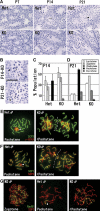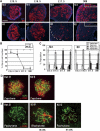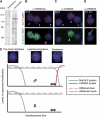Functional dynamics of H3K9 methylation during meiotic prophase progression
- PMID: 17599069
- PMCID: PMC1933398
- DOI: 10.1038/sj.emboj.7601767
Functional dynamics of H3K9 methylation during meiotic prophase progression
Abstract
Histone H3 lysine 9 (H3K9) methylation is a crucial epigenetic mark of heterochromatin formation and transcriptional silencing. G9a is a major mammalian H3K9 methyltransferase at euchromatin and is essential for mouse embryogenesis. Here we describe the roles of G9a in germ cell development. Mutant mice in which G9a is specifically inactivated in the germ-lineage displayed sterility due to a drastic loss of mature gametes. G9a-deficient germ cells exhibited perturbation of synchronous synapsis in meiotic prophase. Importantly, mono- and di-methylation of H3K9 (H3K9me1 and 2) in G9a-deficient germ cells were significantly reduced and G9a-regulated genes were overexpressed during meiosis, suggesting that G9a-mediated epigenetic gene silencing is crucial for proper meiotic prophase progression. Finally, we show that H3K9me1 and 2 are dynamically and sex-differentially regulated during the meiotic prophase. This genetic and biochemical evidence strongly suggests that a specific set of H3K9 methyltransferase(s) and demethylase(s) coordinately regulate gametogenesis.
Figures








Similar articles
-
A histone H3 methyltransferase controls epigenetic events required for meiotic prophase.Nature. 2005 Nov 17;438(7066):374-8. doi: 10.1038/nature04112. Nature. 2005. PMID: 16292313
-
Methylation of a histone mimic within the histone methyltransferase G9a regulates protein complex assembly.Mol Cell. 2007 Aug 17;27(4):596-608. doi: 10.1016/j.molcel.2007.06.026. Mol Cell. 2007. PMID: 17707231
-
The transcriptional repressor JHDM3A demethylates trimethyl histone H3 lysine 9 and lysine 36.Nature. 2006 Jul 20;442(7100):312-6. doi: 10.1038/nature04853. Epub 2006 May 28. Nature. 2006. PMID: 16732292
-
Structure and function of histone H3 lysine 9 methyltransferases and demethylases.Chembiochem. 2011 Jan 24;12(2):254-63. doi: 10.1002/cbic.201000545. Epub 2011 Jan 5. Chembiochem. 2011. PMID: 21243713 Review.
-
Mechanisms of transcriptional repression by histone lysine methylation.Int J Dev Biol. 2009;53(2-3):335-54. doi: 10.1387/ijdb.082717ph. Int J Dev Biol. 2009. PMID: 19412890 Review.
Cited by
-
Chromatin remodelers HELLS, WDHD1 and BAZ1A are dynamically expressed during mouse spermatogenesis.Reproduction. 2022 Dec 2;165(1):49-63. doi: 10.1530/REP-22-0240. Print 2023 Jan 1. Reproduction. 2022. PMID: 36194437 Free PMC article.
-
Transcriptome profiling of histone writers/erasers enzymes across spermatogenesis, mature sperm and pre-cleavage embryo: Implications in paternal epigenome transitions and inheritance mechanisms.Front Cell Dev Biol. 2023 Jan 27;11:1086573. doi: 10.3389/fcell.2023.1086573. eCollection 2023. Front Cell Dev Biol. 2023. PMID: 36776561 Free PMC article.
-
Structure, Activity, and Function of the Protein Lysine Methyltransferase G9a.Life (Basel). 2021 Oct 14;11(10):1082. doi: 10.3390/life11101082. Life (Basel). 2021. PMID: 34685453 Free PMC article. Review.
-
Dynamics of response to asynapsis and meiotic silencing in spermatocytes from Robertsonian translocation carriers.PLoS One. 2013 Sep 16;8(9):e75970. doi: 10.1371/journal.pone.0075970. eCollection 2013. PLoS One. 2013. PMID: 24066189 Free PMC article.
-
dSETDB1 and SU(VAR)3-9 sequentially function during germline-stem cell differentiation in Drosophila melanogaster.PLoS One. 2008 May 21;3(5):e2234. doi: 10.1371/journal.pone.0002234. PLoS One. 2008. PMID: 18493619 Free PMC article.
References
-
- Bourc'his D, Bestor TH (2004) Meiotic catastrophe and retrotransposon reactivation in male germ cells lacking Dnmt3L. Nature 431: 96–99 - PubMed
-
- Buaas FW, Kirsh AL, Sharma M, McLean DJ, Morris JL, Griswold MD, de Rooij DG, Braun RE (2004) Plzf is required in adult male germ cells for stem cell self-renewal. Nat Genet 36: 647–652 - PubMed
-
- Cao R, Zhang Y (2004) The functions of E(Z)/EZH2-mediated methylation of lysine 27 in histone H3. Curr Opin Genet Dev 14: 155–164 - PubMed
-
- Carmell MA, Girard A, van de Kant HJ, Bourc'his D, Bestor TH, de Rooij DG, Hannon GJ (2007) MIWI2 is essential for spermatogenesis and repression of transposons in the mouse male germline. Dev Cell 12: 503–514 - PubMed
Publication types
MeSH terms
Substances
LinkOut - more resources
Full Text Sources
Molecular Biology Databases

